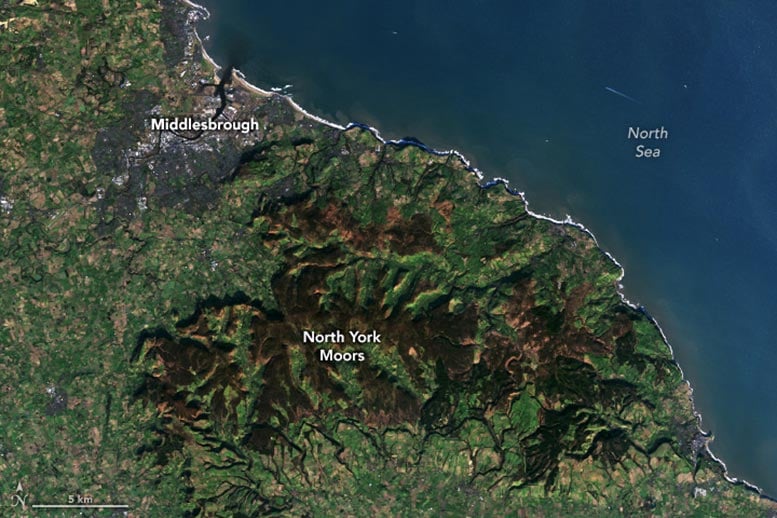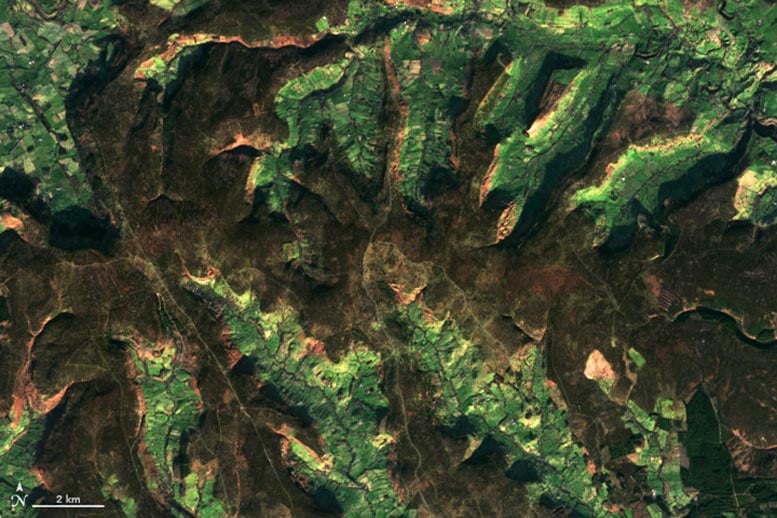
Carbon Storage in the Majestic Moors of Yorkshire
-
by Anoop Singh
- 7

Satellite image of the North York Moors in Yorkshire, England captured on December 26, 2023, by the Operational Land Imager-2 on Landsat 9.
Rolling hills of peaty soil store thousands of years of plant matter in northeastern England.
The North York Moors National Park in Yorkshire features rolling hills and expansive moorlands. Designated in 1952, the park is notable for its purple flowering heather and deep peat soils, which are essential for carbon storage. Satellite imagery helps monitor these landscapes, while conservation initiatives focus on restoring peat ecosystems to combat degradation.
The North York Moors in Yorkshire, England, is a place where time seems to stand still. Wide-open undulating hills, interspersed with 18th-century farmhouses, store thousands of years of peat beneath flowering heather. The open hills of moorland landscapes inspired scenery in Wuthering Heights and Jane Eyre by Emily and Charlotte Brontë, who grew up among the moors of western Yorkshire.
Landsat 9’s OLI-2 (Operational Land Imager-2) captured this image of the North York Moors on December 26, 2023. The moors themselves, brown in this image, become seas of blooming purple flowers in late August and September. Shrubs growing on the upland moors give them their darker color. Between the moors, valleys that were gouged out by glacial meltwater appear light green. (If the valleys look more like plateaus, you might be experiencing relief inversion.)

Detailed view from the satellite image above.
The North York Moors, covering approximately 1,430 square kilometers (550 square miles), was designated as a national park in 1952. The park contains one of the largest expanses of carbon-rich moorland in England. Moorland generally refers to upland landscapes covered in heather shrubs (Calluna vulgaris), which flower a rich purple in the late summer (seen in the photo below). Heather grows on blanket bogs as well as shallow peat and mineral soils that are dry enough to walk on.
In England’s wet and cold climate, vegetation doesn’t decompose readily. Sphagnum moss and grass build up organic matter over time, forming peat—partly decayed plant material. Heather, bilberries, and grasses then grow on the layers of peat.

Sea and sky, Robin Hood’s Bay, blooming heather in the North York Moors on August 21, 2019. Credit: Dave Morton, Flickr
Much of the North York Moors is covered in shallow peat, less than 40 centimeters deep. But in the middle of the park, about 5,000 hectares of deep peat have been storing carbon for thousands of years. The deepest peat in the park (about 6 meters) is thought to be up to 6,000 years old. However, some peatlands have been degraded and eroded due to artificial drainage for agriculture, and some have been damaged by fires.
A partnership of organizations is working to restore peat-building ecosystems in the North York Moors by re-wetting and re-vegetating land. They are also creating open-source technologies for remote monitoring of peatland habitats in Yorkshire, using Landsat and Sentinel satellites. As of March 2023, the partnership had restored 42,000 hectares of peat.
NASA Earth Observatory images by Wanmei Liang, using Landsat data from the U.S. Geological Survey.
Satellite image of the North York Moors in Yorkshire, England captured on December 26, 2023, by the Operational Land Imager-2 on Landsat 9. Rolling hills of peaty soil store thousands of years of plant matter in northeastern England. The North York Moors National Park in Yorkshire features rolling hills and expansive moorlands. Designated in 1952,…
Satellite image of the North York Moors in Yorkshire, England captured on December 26, 2023, by the Operational Land Imager-2 on Landsat 9. Rolling hills of peaty soil store thousands of years of plant matter in northeastern England. The North York Moors National Park in Yorkshire features rolling hills and expansive moorlands. Designated in 1952,…
